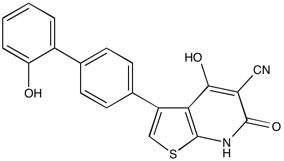A-769662 | AMPK activator
NMR (Conforms)

Available Options
| size : | Price | Quantity | |
|---|---|---|---|
| 5 mg | $72.00 | ||
| 25 mg | $250.00 |
A-769662 (844499-71-4) is a potent and reversible AMP-activated protein kinase (AMPK) allosteric activator. Activates AMPK by binding to the β and γ subunits and not the AMP binding site.1 EC50=0.8 µM for purified rat liver AMPK and inhibits fatty acid biosynthesis in rat hepatocytes IC50=3.2 µM.2 A-769662 inhibits the rate of whole-body fatty acid oxidation, decreases body weight gain, reduces plasma and liver triglycerides and lowers plasma glucose in ob/ob mice.2 Inhibits adipocyte differentiation.3 Prevents transcriptional activation of Oct4 and establishes a metabolic barrier to induced pluripotent stem cell reprogramming.4 A-769662 synergizes with AICAR.5 Cell permeable.
References/Citations
1) Scott et al. (2008), Thienopyridone drugs are selective activators of AMP-activated protein kinase beta1-containing complexes; Cell Biol., 15 1220
2) Cool et al. (2006), Identification and characterization of a small molecule AMPK activator that treats key components of type 2 diabetes and the metabolic syndrome; Cell Metab., 3 403
3) Zhou et al. (2009), Inhibitory effects of A-769662, a novel activator of AMP-activated protein kinase on 3T3-L1 adipogenesis; Biol. Pharm. Bull., 32 993
4) Vazquez-Martin et al. (2012) Activation of AMP-activated protein kinase (AMPK) provides a metabolic barrier to reprogramming somatic cells into stem cells; Cell Cycle, 11 974
5) Ducommun et al. (2014) Enhanced activation of cellular AMPK by dual-small molecule treatment: AICAR and A769662; Am. J. Physiol. Endocrinol. Metab., 306 E688
NMR (Conforms)
Safety Data Sheet:
Product Data Sheet:
Materials provided by Focus Biomolecules are for laboratory research use only and are not intended for human or veterinary applications. Please note that we do not sell to individuals and that all orders placed by non-research organizations will incur a $20 restocking/refund fee
A-769662 (844499-71-4) is a potent and reversible AMP-activated protein kinase (AMPK) allosteric activator. Activates AMPK by binding to the β and γ subunits and not the AMP binding site.1 EC50=0.8 µM for purified rat liver AMPK and inhibits fatty acid biosynthesis in rat hepatocytes IC50=3.2 µM.2 A-769662 inhibits the rate of whole-body fatty acid oxidation, decreases body weight gain, reduces plasma and liver triglycerides and lowers plasma glucose in ob/ob mice.2 Inhibits adipocyte differentiation.3 Prevents transcriptional activation of Oct4 and establishes a metabolic barrier to induced pluripotent stem cell reprogramming.4 A-769662 synergizes with AICAR.5 Cell permeable.
References/Citations
1) Scott et al. (2008), Thienopyridone drugs are selective activators of AMP-activated protein kinase beta1-containing complexes; Cell Biol., 15 1220
2) Cool et al. (2006), Identification and characterization of a small molecule AMPK activator that treats key components of type 2 diabetes and the metabolic syndrome; Cell Metab., 3 403
3) Zhou et al. (2009), Inhibitory effects of A-769662, a novel activator of AMP-activated protein kinase on 3T3-L1 adipogenesis; Biol. Pharm. Bull., 32 993
4) Vazquez-Martin et al. (2012) Activation of AMP-activated protein kinase (AMPK) provides a metabolic barrier to reprogramming somatic cells into stem cells; Cell Cycle, 11 974
5) Ducommun et al. (2014) Enhanced activation of cellular AMPK by dual-small molecule treatment: AICAR and A769662; Am. J. Physiol. Endocrinol. Metab., 306 E688
Related Cancer Cell Metabolism Metabolic Kinase Products
Download
Calculate the molar concentration, mass or volume in a solution.
Concentration × Volume × Molecular Weight = Mass
Focus Biomolecules • Plymouth Meeting, PA USA • 1-855-FOCUS21
Focus Biomolecules
Plymouth Meeting, PA USA
1-855-FOCUS21
Website Created by Advanta Advertising LLC.

